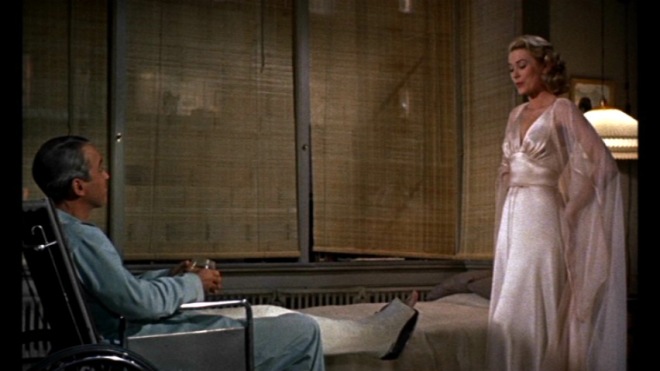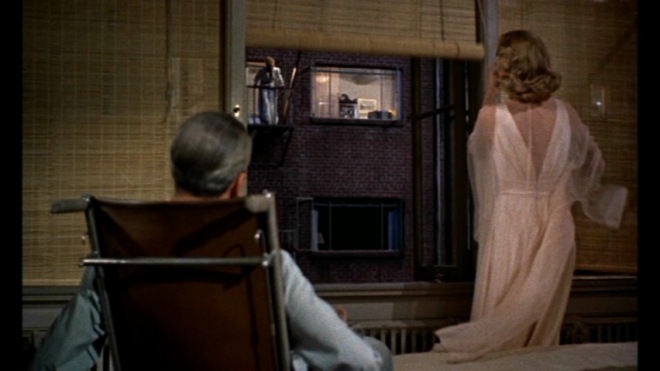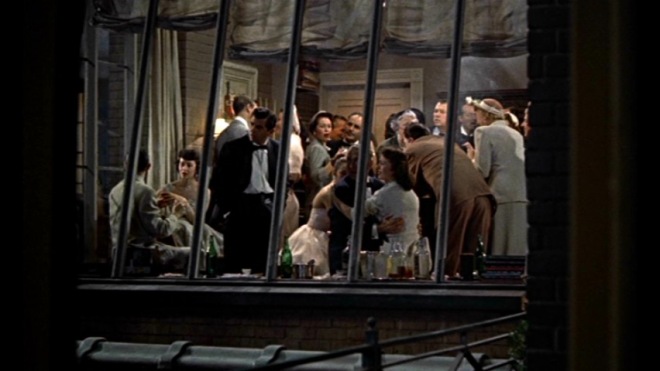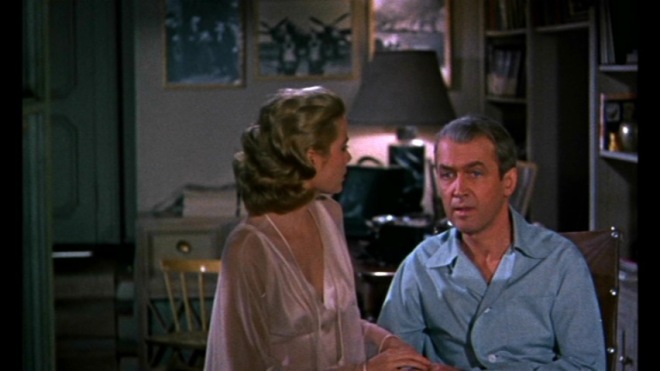Perhaps Rear Window doesn’t have an iconic scene in the way that North by Northwest and Psycho do, but it does have several scenes that are worth taking a closer look at. The one I chose is the scene in which the little dog is discovered dead. This is an important scene for many reasons. It is the most heartfelt moment in the movie; we feel more sorrow for the dog than we ever did for Mrs. Thorwald. It is also important for advancing the plot, for we learn that Thorwald doesn’t react to the commotion in the courtyard. And finally, from a technical standpoint, it is shot in different manner than the rest of the film.
This sequence, from fade-in at 1:22:30 to fade-out at 1:25:03, has 40 editorial cuts. This averages out to one cut approximately every 3.8 seconds. Many of the clips are much shorter than that. Hitchcock explained in an interview that the cutting gets faster as the film progresses and the tension increases. This scene has the fastest cutting we have seen up to this point in the movie.
The scene fades in on Jeff, sipping the last of his brandy.
Lisa exits the bathroom, and walks over to the window, without any cutting. Look at the way Jeff and Lisa are staged here; they are seen in a long shot, with a considerable distance between them.
They then hear a scream, and Lisa opens up the center blind. Notice the nice framing here, as you can see the woman on her balcony.
Next we cut to a mid-range shot of the woman, in distress, and we learn she is reacting to her dog, lying prone in the courtyard below.
We then get a series of shots in rapid succession, very quick cuts of many of the residents of the courtyard reacting to the drama. These shots last an average of 2 seconds each. We see the composer’s apartment first.
Then we get, in rapid succession, the newlyweds, Miss Torso, the sculptress, Miss Lonelyhearts, and even the couple on the high upper right balcony, who do not have a “story” in the movie but can be observed in a few scenes. Finally Miss Lonelyhearts leans over the dog, and observes that it is dead, its neck broken.
Up to this point, all of the camera angles have been the ones we are used to. Everything is from Jeff’s apartment, or rather Jeff’s point of view. We see what he sees, as we have for the entire movie. Now, for just one moment, Hitchcock will do something entirely different. He will break with his own “camera logic” and give us a few brief shots that can’t be from Jeff’s point of view. As the dog owner is addressing the courtyard: “Which one of you did it?” we get this long shot.
This could still be Jeff’s point of view, but look how much of the courtyard we are taking in. The dog owner continues to berate the neighbors as she cries. “You don’t know the meaning of the word ‘neighbors'”. But look at this camera angle, this can’t possibly be from Jeff’s apartment.
What a fantastic framing, looking up as the dog owner says “you don’t know the meaning of the word neighbors.” We can also see both Miss Torso and the head of the sculptress. This shot lasts less than three seconds. Miss Lonelyhearts puts the dog in the basket, again from Jeff’s point of view.
The lady continues her very moving speech. “He was the only thing in this whole neighborhood that liked anybody.”
We see the newlyweds, looking out of their window, very concerned. Next we get this wonderful shot.
What a beautiful, expressive image of Miss Torso! And whose point of view is this supposed to be? Finally the basket has nearly reached the top.
Her heartfelt remarks are coming to a close, as she continues to accuse everyone in the courtyard. “Did you kill him because he liked you?” When we next see Lisa and Jeff, it is a mid-range shot, and they have drawn closer together.
From this we cut to another beautiful, expressive shot, this time of Miss Lonelyhearts.
Finally, the man takes the dog from the basket, and the couple go inside.
Then, just as we saw everyone react to the scream, now we see them all, in quick cuts, return to their routine. And we are back in familiar territory visually, with every shot from Jeff’s point of view. The party goers disperse at the composers.
We then see the newlyweds put their heads in, and close the blind. The couple on the far upper right balcony get another shot. Miss Torso goes inside and closes her door. The sculptress does the same.
When we next see Lisa and Jeff, they are even closer together.
Then Jeff tells Lisa that there was only one person in the whole courtyard that didn’t come to the window to look, and we get this wonderful shot, of Thorwald’s cigarette glowing in the dark like a malevolent eye.
The scene ends on Lisa and Jeff, and they are yet again even closer, as close as they can be.
So what did Hitchcock accomplish in this mere two and a half minutes of film? He told us that Thorwald is a dog killer, and he told us in a strikingly visual way. He gave us a very emotional scene, in which the dog owner berates everyone for not being good enough neighbors. Why does Hitchcock break his own rule, and give us a few very brief shots that are not from Jeff’s point of view? Because this is the most emotional scene in the film, and those images heighten the emotion. The images are very quick cuts, so the viewer will most likely be too caught up in the story to notice or question Hitchcock’s camera logic. It is powerful and effective filmmaking, and does not break with the concept of montage that he uses throughout.
And finally, we see a strengthening of the bond between Jeff and Lisa. At the beginning, there is a gulf between them. This little tragedy, the death of a dog, and the knowledge of its killer and what that may mean, bring them as closer together.
Here we see how the power of cutting, and artfully framing actors, are tools that can advance the story and enhance the emotional response of the audience. This is the master at his best.



















Some of your best writing. I need to see this film again soon.
Thanks. You can borrow my blu-ray if you want. The picture quality is amazing in HD.
Amazing 👏🏻
You have deconstructed the scene so well. I am going to watch the movie again.
I belong to a original perry mason site for fans. I’ve never, ever liked Jimmy Stewart, but, found out that he and burr did Rear Window. Ive watched a lot of Alfred Hitchcocks shows so gave it a try. I actually Stewart in this. What a performance by Burr! I bought this movie from Ebay, after seeing this on VOD!
One of my fav movies. I’ve watched it several times but you bought it to another level of thought. Thank you 👍
So why did Lars kill the dog?
why did Lars kill the dog? And why does he draw attention to himself by not reacting to its death?
I’ve seen all of Hitchcock movies.
Rear window is pbly one of his best. Although Psycho is another masterpiece. I guess I can’t decide which is the BEST….
Killing the dog isn’t logical. If he killed the dog first there is no reason to remove the head from the Hardin; if he removes the head first there is no reason to kill the dog. And, just when and where did he kill the and leave in plain sight.